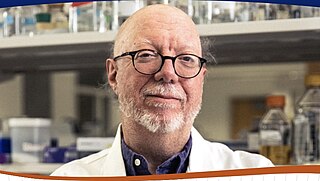Related Research Articles
A distributed system is a system whose components are located on different networked computers, which communicate and coordinate their actions by passing messages to one another. Distributed computing is a field of computer science that studies distributed systems.
An actuator is a component of a machine that produces force, torque, or displacement, usually in a controlled way, when an electrical, pneumatic or hydraulic input is supplied to it in a system. An actuator converts such an input signal into the required form of mechanical energy. It is a type of transducer. In simple terms, it is a "mover".

Theoretical computer science (TCS) is a subset of general computer science and mathematics that focuses on mathematical aspects of computer science such as the theory of computation, formal language theory, the lambda calculus and type theory.
Quantum information science is a field that combines the principles of quantum mechanics with information theory to study the processing, analysis, and transmission of information. It covers both theoretical and experimental aspects of quantum physics, including the limits of what can be achieved with quantum information. The term quantum information theory is sometimes used, but it does not include experimental research and can be confused with a subfield of quantum information science that deals with the processing of quantum information.
Computronium is a material hypothesized by Norman Margolus and Tommaso Toffoli of MIT in 1991 to be used as "programmable matter", a substrate for computer modeling of virtually any real object.

A block cellular automaton or partitioning cellular automaton is a special kind of cellular automaton in which the lattice of cells is divided into non-overlapping blocks and the transition rule is applied to a whole block at a time rather than a single cell. Block cellular automata are useful for simulations of physical quantities, because it is straightforward to choose transition rules that obey physical constraints such as reversibility and conservation laws.
Unconventional computing is computing by any of a wide range of new or unusual methods. It is also known as alternative computing.
Modular self-reconfiguring robotic systems or self-reconfigurable modular robots are autonomous kinematic machines with variable morphology. Beyond conventional actuation, sensing and control typically found in fixed-morphology robots, self-reconfiguring robots are also able to deliberately change their own shape by rearranging the connectivity of their parts, in order to adapt to new circumstances, perform new tasks, or recover from damage.
Programmable matter is matter which has the ability to change its physical properties in a programmable fashion, based upon user input or autonomous sensing. Programmable matter is thus linked to the concept of a material which inherently has the ability to perform information processing.
Amorphous computing refers to computational systems that use very large numbers of identical, parallel processors each having limited computational ability and local interactions. The term Amorphous Computing was coined at MIT in 1996 in a paper entitled "Amorphous Computing Manifesto" by Abelson, Knight, Sussman, et al.
The Advanced Learning and Research Institute (ALaRI), a faculty of informatics, was established in 1999 at the University of Lugano to promote research and education in embedded systems. The Faculty of Informatics within very few years has become one of the Switzerland major destinations for teaching and research, ranking third after the two Federal Institutes of Technology, Zurich and Lausanne.

Bruce Randall Donald is an American computer scientist and computational biologist. He is the James B. Duke Professor of Computer Science and Biochemistry at Duke University. He has made numerous contributions to several fields in Computer Science such as robotics, Microelectromechanical Systems (MEMS), Geometric & physical algorithms and computational geometry, as well as in areas of Structural Molecular Biology & Biochemistry such as Protein design, Protein Structure Determination and Computational Chemistry.
Norman H. Margolus is a Canadian-American physicist and computer scientist, known for his work on cellular automata and reversible computing. He is a research affiliate with the Computer Science and Artificial Intelligence Laboratory at the Massachusetts Institute of Technology.

A reversible cellular automaton is a cellular automaton in which every configuration has a unique predecessor. That is, it is a regular grid of cells, each containing a state drawn from a finite set of states, with a rule for updating all cells simultaneously based on the states of their neighbors, such that the previous state of any cell before an update can be determined uniquely from the updated states of all the cells. The time-reversed dynamics of a reversible cellular automaton can always be described by another cellular automaton rule, possibly on a much larger neighborhood.
Robotic sensing is a subarea of robotics science intended to provide sensing capabilities to robots. Robotic sensing provides robots with the ability to sense their environments and is typically used as feedback to enable robots to adjust their behavior based on sensed input. Robot sensing includes the ability to see, touch, hear and move and associated algorithms to process and make use of environmental feedback and sensory data. Robot sensing is important in applications such as vehicular automation, robotic prosthetics, and for industrial, medical, entertainment and educational robots.
Mechanical metamaterials are artificial structures with mechanical properties defined by their structure rather than their composition. They can be seen as a counterpart to the rather well-known family of optical metamaterials. They are often also termed elastodynamic metamaterials and include acoustic metamaterials as a special case of vanishing shear. Their mechanical properties can be designed to have values which cannot be found in nature.
The Rice University Department of Electrical and Computer Engineering is one of nine academic departments at the George R. Brown School of Engineering at Rice University. Ashutosh Sabharwal is the Department Chair. Originally the Rice Department of Electrical Engineering, it was renamed in 1984 to Electrical and Computer Engineering.

Nikolaus Correll is a roboticist and an associate professor at the University of Colorado at Boulder in the Department of Computer Science with courtesy appointments in the departments of Aerospace, Electrical and Materials Engineering. Nikolaus is the faculty director of the Interdisciplinary Research Theme on Multi-functional Materials at the College of Engineering and Applied Science, and the founder and CTO of Robotic Materials Inc.

Soft robotics is a subfield of robotics that concerns the design, control, and fabrication of robots composed of compliant materials, instead of rigid links. In contrast to rigid-bodied robots built from metals, ceramics and hard plastics, the compliance of soft robots can improve their safety when working in close contact with humans.

Alper Erturk is a mechanical engineer and the Woodruff Professor in the George W. Woodruff School of Mechanical Engineering at Georgia Institute of Technology.
References
- 1 2 3 4 M. A. McEvoy and N.Correll. Materials that couple sensing, actuation, computation, and communication, Science Vol. 347 no. 6228 DOI: 10.1126/science.1261689
- ↑ R. M. Walser, Electromagnetic metamaterials. Proc. SPIE 4467, Complex Mediums II: Beyond Linear Isotropic Dielectrics (San Diego, CA, 2001), pp. 1–15 (2001).
- 1 2 T. Toffoli, N. Margolus, Programmable matter: Concepts and realization. Physica D 47, 263–272 (1991). 10.1016/0167-2789(91)90296
- ↑ Robotic materials: Changing with the world around them, phys.org, March 19, 2015.
- ↑ Autonomous Materials will let future robots change color and shift shape, Popular Science, March 19, 2015.
- ↑ Hughes, Dana (2019). "Materials that make robots smart". International Journal of Robotics Research. 38 (12–13): 1338–1351. arXiv: 1711.00537 . doi: 10.1177/0278364919856099 .
- ↑ Materials that Couple Sensing, Actuation, Computation and Communication, Computing Community Consortium (CCC) "Great Innovative Ideas", November 2, 2015.
- ↑ Kaya, Kerem; Kravchenko, Alexander; Scarpellini, Claudia; Iseri, Emre; Kragic, Danica; van der Wijngaart, Wouter (2023). "Programmable Matter with Free and High-Resolution Transfiguration and Locomotion". Advanced Functional Materials. doi: 10.1002/adfm.202307105 .